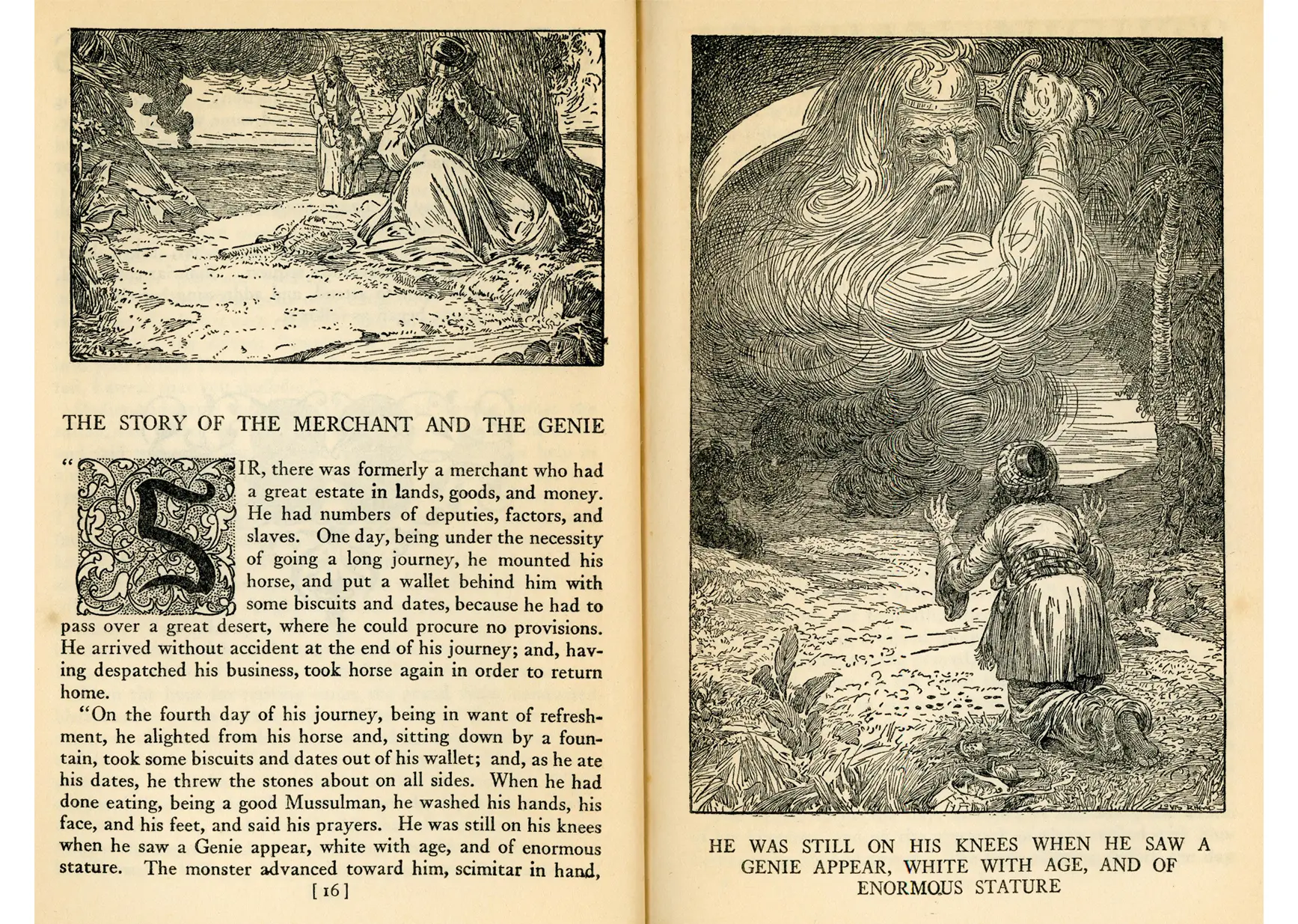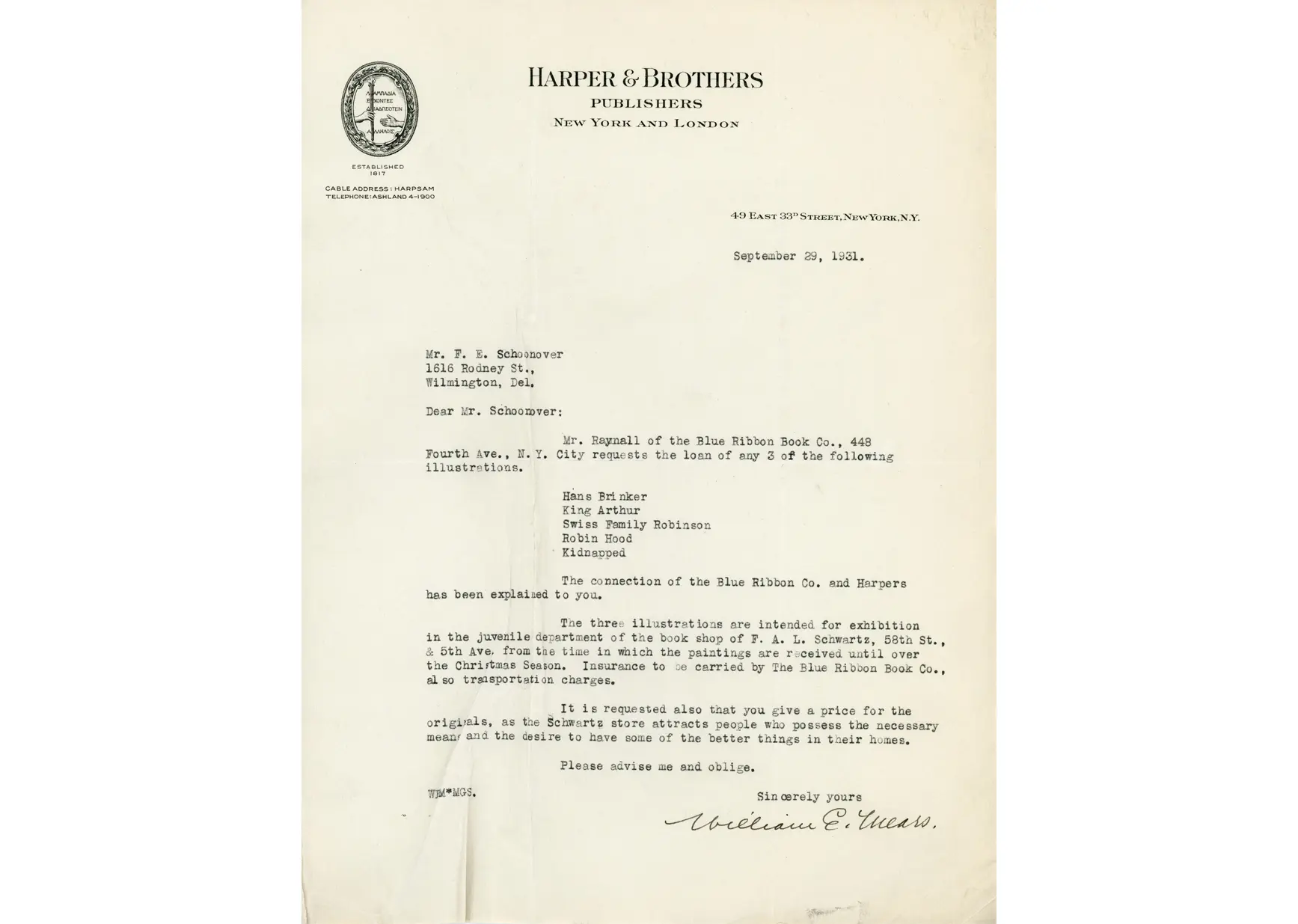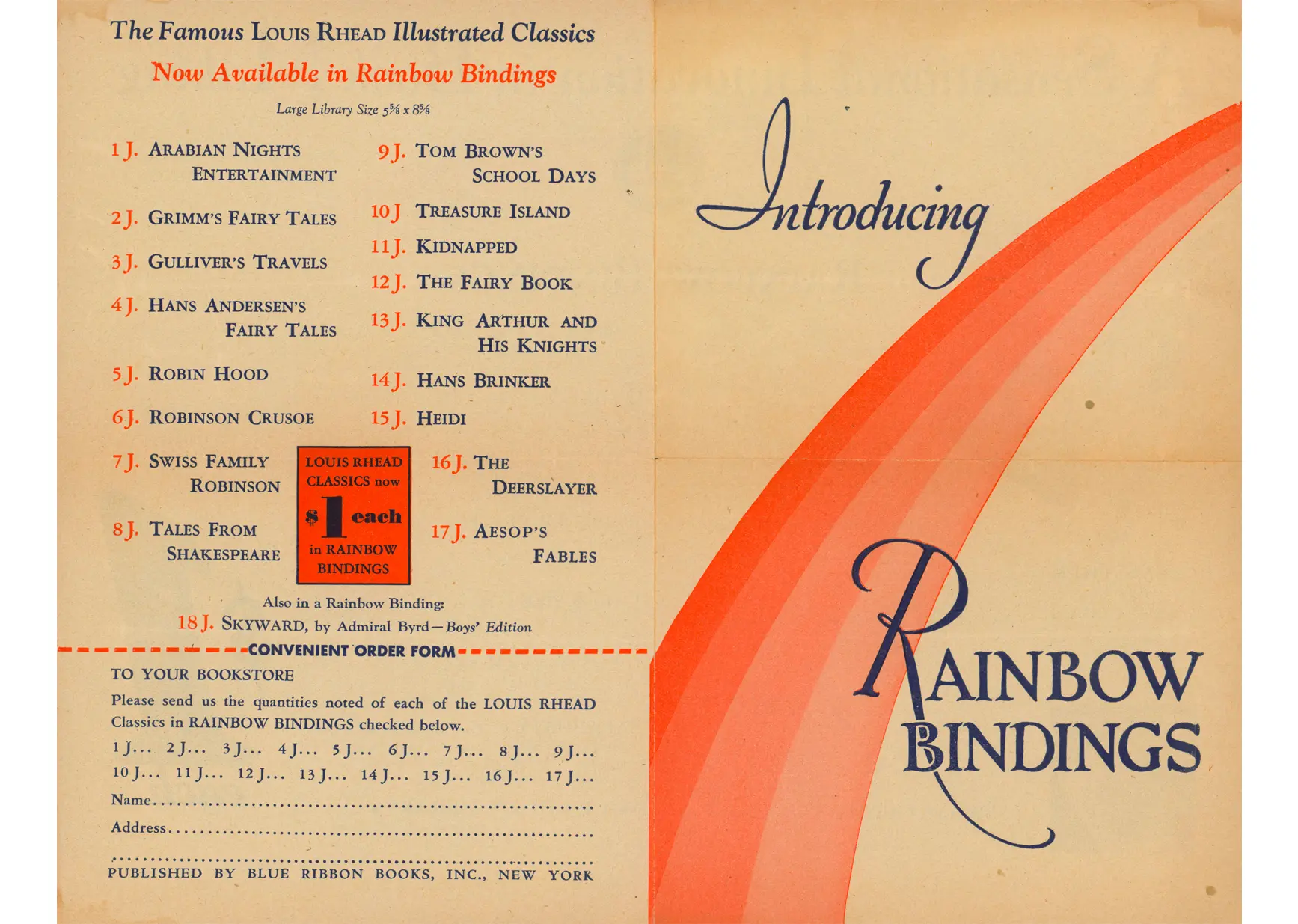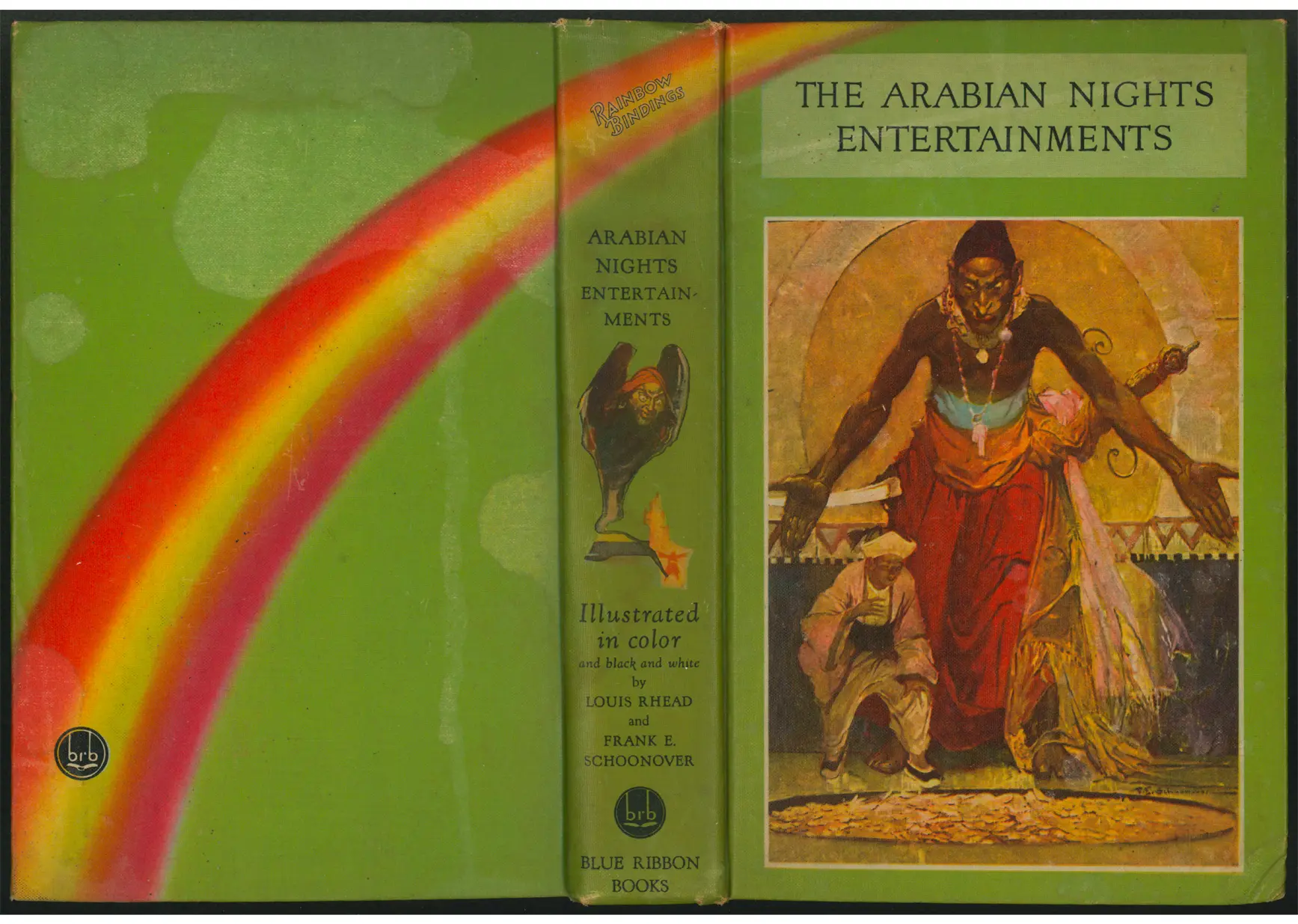Figure 1 (above). The Arabian Nights Entertainments (New York: Blue Ribbon Books, 1931). Helen Farr Sloan Library & Archives, Delaware Art Museum, Gift of Robert and Mary Walsh.
Recently, Delaware Art Museum Members Bob and Mary Walsh donated a few boxes of books to the Museum’s Library. For years the Walshes have been hunting down publishers’ bindings on their travels and very generously purchasing them for the library, and I am always excited when Mary brings in their latest finds. This time around I was doubly excited, as one of the books held an extra treasure inside its colorful cover. The book, The Arabian Nights Entertainments, illustrated by Louis Rhead and Frank E. Schoonover, is part of the Rainbow Bindings series published by Blue Ribbon Books. Schoonover’s cover illustration presents a bare-chested and bejeweled genie framed by a Moorish arch. The towering genie’s exaggerated features, dark skin, and exotic attire—as well as the dazzling scimitar slung across his back—create an orientalist fantasy that mirrors Arab stereotypes reflected in the stories. (See this article for more information about the role the Arabian Nights stories played in creating such stereotypes.)
We have other titles from this series in the Frank E. Schoonover Library Collection, but this one contained an advertising brochure aimed at booksellers—a rare piece of ephemera that I hadn’t seen before. This, of course, sent me down a rabbit hole of research to find out everything I could about the series. Unfortunately, there isn’t much information out there, which makes this brochure even more valuable.
In 1930 a consortium of publishers (Dodd, Mead & Company, Harcourt, Brace & Company, Harper & Brothers, and Little, Brown and Company) established Blue Ribbon Books as a reprint publisher, intent on competing with Grosset & Dunlap, who had built a very profitable business by purchasing softcover books and rebinding them as hardcovers. The publishing firms behind Blue Ribbon Books drew on titles from their back catalogs to produce affordable reprints for just $1.00 (roughly $18.00 in today’s money) and promoted them with the statement “The success of this book as originally published at $3.00 makes possible the Blue Ribbon edition at one dollar.”
 Figure 2. Promotional paper band, which originally would have been wrapped around the dust jacket
Figure 2. Promotional paper band, which originally would have been wrapped around the dust jacket
In the fall of 1931 Blue Ribbon Books introduced Rainbow Bindings for the juvenile book market. For this series, Harper & Brothers tapped their catalog of Louis Rhead Classics and reprinted them in colorful and durable bindings. Rhead (1857–1926) was one of the most popular designers and illustrators of the early twentieth century and an unofficial rival of Howard Pyle, particularly in the field of illustrated juvenile classics. Appearing just in time for the Christmas gift season, these Rainbow Bindings were advertised as being both beautiful and indestructible, designed to “brighten and decorate children’s bookshelves” and be wiped clean with a damp cloth. A review in the article “The Christmas Book Shelf” from the December 1931 issue of The Elementary English Review recommended the books, stating that they are “attractively bound . . . [and] are gifts of unusual merit and not unpleasing to a youthful eye.”
 Figure 3. Rhead’s illustrations from The Arabian Nights Entertainments
Figure 3. Rhead’s illustrations from The Arabian Nights Entertainments
Each book in the series contained numerous illustrations and decorations by Rhead and featured a full color illustration by Schoonover that was used for both the frontispiece and the cover. This was not the first time the two artists had shared the role of illustrator—a decade earlier they had collaborated on several successful reprints of classics published by Harper & Brothers. A letter to Schoonover from Rhead in the Frank E. Schoonover Manuscript Collection explains how this relationship initially came about, and why Rhead was happy to share the credit with Schoonover:
I welcome your pictures in the books. It gives a joyous tone to the serious somberness of pen work. You may not know it, Harper’s acted nice about it. From a business standpoint, they knew American mothers are attracted by a color picture (if good), and they asked me to do it – I told them I could – but it would be better to have work from a man whose regular work was color – and it was I who suggested you to them. And glad I am they acted and got you, for it has boosted up sales.
 Figure 4. Letter from Louis Rhead to Frank E. Schoonover, c. 1923. Frank E. Schoonover Manuscript Collection, Helen Farr Sloan Library & Archives, Delaware Art Museum
Figure 4. Letter from Louis Rhead to Frank E. Schoonover, c. 1923. Frank E. Schoonover Manuscript Collection, Helen Farr Sloan Library & Archives, Delaware Art Museum
When Blue Ribbon Books decided to reprint the Rhead classics in their new Rainbow Bindings series they contacted Schoonover, asking him to send to them his original small spine illustrations so that they could make new plates from them. Schoonover, obviously confused, must have sent a letter to Harper’s asking about this. Although the initial request from Blue Ribbon and Schoonover’s query to Harper’s are not in our collection, Harper’s reply to Schoonover, in which they inform him that Blue Ribbon Books is part of their company, is, as is another letter asking him to send along three of his cover illustrations so that they could be displayed in the juvenile book shop at F. A. O. Schwartz over the Christmas season.
 Figure 5. A selection of Rainbow Bindings from the Frank E. Schoonover Library Collection showing Schoonover’s spine illustrations
Figure 5. A selection of Rainbow Bindings from the Frank E. Schoonover Library Collection showing Schoonover’s spine illustrations
 Figure 6. Letter from William E. Mears, Harper & Brothers, to Frank E. Schoonover, 1931. Frank E. Schoonover Manuscript Collection, Helen Farr Sloan Library & Archives, Delaware Art Museum. In this letter Mears asks Schoonover to send three of his original paintings for display in the book department of F. A. O. Schwartz over the Christmas season. He also requests a price for the originals, “as the Schwartz store attracts people who possess the necessary means and the desire to have some of the better things in their homes.” Schoonover sent five paintings for display, all of which were returned to him in early 1932.
Figure 6. Letter from William E. Mears, Harper & Brothers, to Frank E. Schoonover, 1931. Frank E. Schoonover Manuscript Collection, Helen Farr Sloan Library & Archives, Delaware Art Museum. In this letter Mears asks Schoonover to send three of his original paintings for display in the book department of F. A. O. Schwartz over the Christmas season. He also requests a price for the originals, “as the Schwartz store attracts people who possess the necessary means and the desire to have some of the better things in their homes.” Schoonover sent five paintings for display, all of which were returned to him in early 1932.
Though finding these letters in our collections was exciting as they helped me piece together more information about the series, the real star of this story is the brochure itself. Calling the series “A Sensational Innovation in Book Making,” the brochure touts the technological advancements that make the Rainbow Bindings unique:
For the first time in the history of book making a way has been discovered of reproducing on the cloth cover of a book miniature oil paintings which retain the full beauty and color of the original. It is a truly amazing discovery, developed and distributed solely by Blue Ribbon Books. “Rainbow Bindings”, as these covers will be called, are washable and indestructible, and add an indescribable distinction to America’s most famous series of Juvenile classics.

 Figures 7 and 8. “Introducing Rainbow Bindings” advertising brochure. Helen Farr Sloan Library & Archives, Delaware Art Museum, Gift of Robert and Mary Walsh.
Figures 7 and 8. “Introducing Rainbow Bindings” advertising brochure. Helen Farr Sloan Library & Archives, Delaware Art Museum, Gift of Robert and Mary Walsh.
The brochure continues by highlighting the series’ “11 Unusual Features,” including novelty (“Nothing like ‘Rainbow Bindings’ have ever been offered”), durability (“‘Rainbow Bindings’ are specially treated and will not tear, break, crack or fray”), and quality (“Although ‘Rainbow Bindings’ are low in price they give an appearance of quality that cannot be equaled by any other line of children’s books”). The brochure also notes that the technological innovation of producing the color illustration directly onto the cloth results in a superior reproduction than if it had been printed on a paper jacket or inlay, as was the previous fashion. In fact, Eugene Reynal, head of Blue Ribbon Books, was so confident about this new format that he was quoted by the Kansas City Star as declaring that “paper book jackets will soon be a thing of the past.” But perhaps the most compelling reason to purchase the Rainbow Bindings series, according to the brochure, and the one that must have appealed the most to Rhead’s “American mothers,” is the claim that “a love for these books will give [children] a love for books all their lives.”
Rachael DiEleuterio
Librarian and Archivist

